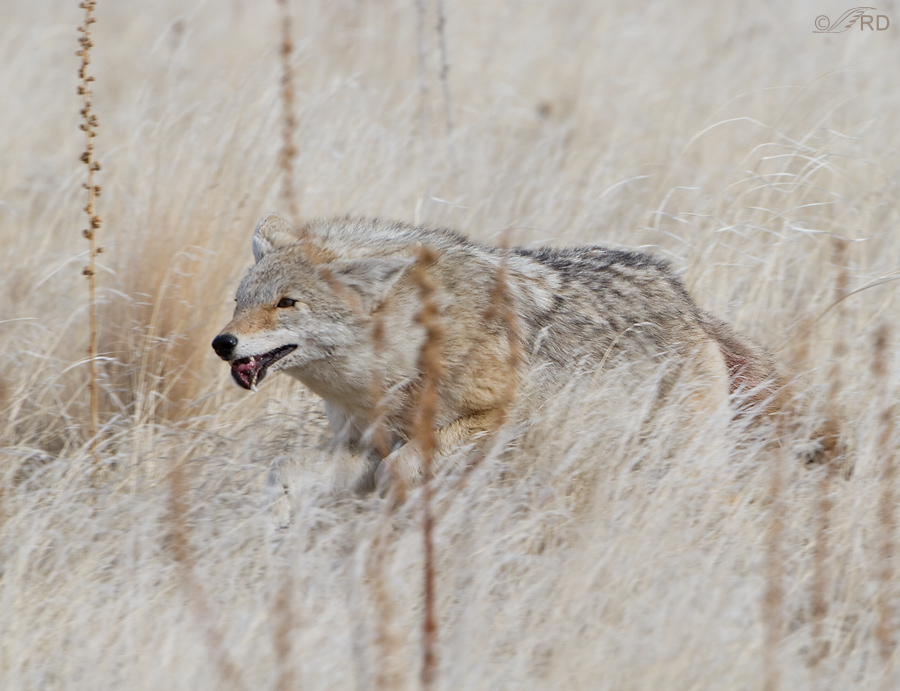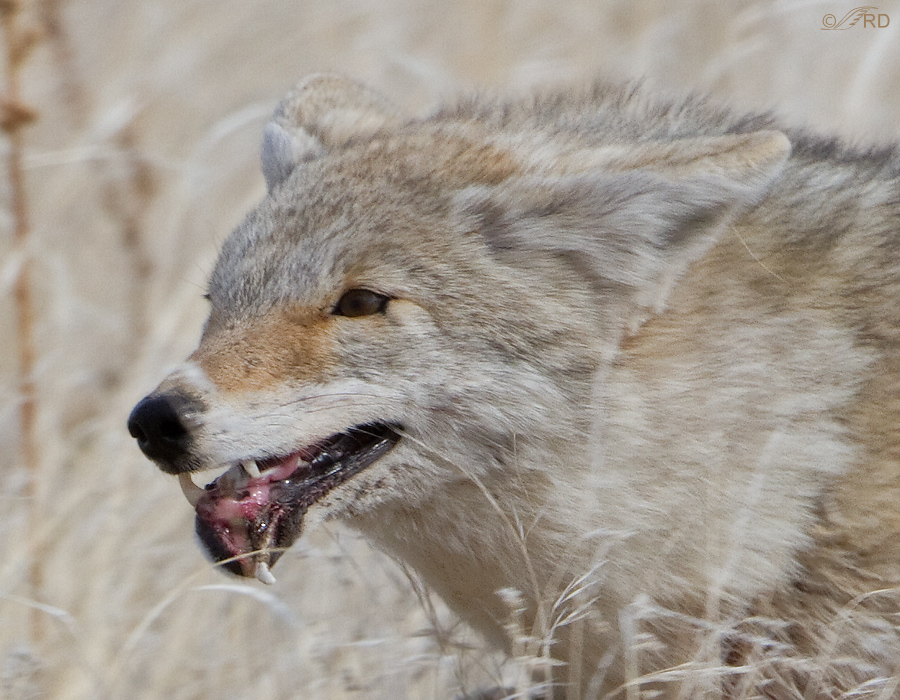I’ve always thought that nature photographers are some of the luckiest folks on the planet because we get to spend so much time in the natural world that we love and we see some of the most exhilirating sights and wonderous events that nature has to offer. But occasionally there’s a dark side. Yesterday was a difficult day in the field for me on Antelope Island.
Be forewarned that the photos are of documentary quality only and that at least one of them may be difficult for some to view.
When we spotted this coyote hunting in the grass for voles it was successful almost immediately and quickly swallowed its lunch. A few seconds later I noticed that it looked like it had caught another vole because I thought I could see the vole hanging out the left side of it’s mouth – the grasses were thick and it was difficult to tell.
Then we spotted another coyote about a quarter mile behind this one and within a few seconds this animal also caught sight of the second coyote. When it did so there was an instantantaneous reaction – it put its ears down, its tail between its legs and started running through the grass like a bat out of hell to get away from the second coyote. I fired off a few shots as it ran but certainly didn’t get anything to be proud of.
It wasn’t until I got home and processed the running shots that I knew something was terribly wrong. This image is atrocious because it’s a massive crop to show detail and because the coyote was running full speed but it does show fairly well the awful injury this animal had sustained. I’m no veterinarian or dentist but it appears to me that this coyote has had it’s lower left canine tooth pulled sideways out of the jaw bone, breaking the lower mandible in the process. The tooth seems to be hanging on only by some soft tissue and the lower lip has a serious droop. In addition this animal had noticable blood on its rump and the base of its tail.
I can only guess how this happened. Perhaps it was caused by a fight between the two coyotes – the obvious fear this animal demonstrated at the sight of the other coyote and the fact that it is now coyote breeding season (I observed two coyotes mating earlier this week) lead me in that direction. It’s also possible that there was some sort of altercation with one of the bison who are so plentiful on the island but I’m skeptical of that. I’ve seen and documented (here) disputes between coyotes and pronghorn so that’s possible too. I just don’t know…
The coyote ran a long ways to escape its apparent tormentor and didn’t begin to relax (or put its ears back up) until it had rounded a large hill and could no longer see the other coyote. This image shows the angle at which the tooth is hanging.
But even when it felt relatively safe it kept looking back to see if the second coyote was following.
There’s nothing to be done for this animal of course. The policy of Antelope Island State Park is to let nature take its course and I support that policy.
On a clinical level I fully realize that it’s a harsh world “out there” and that these kinds of events are commonplace in nature. Still, reality sometimes gives me a sucker punch. This was one of those days.
Ron






Ron, a beautifully documented series of a sad situation! As a wildlife rehabilitator, my impulse is obviously to “rescue,” although I’m careful to assess each situation based on a number of important criteria. I find that parks and organizations have various policies when it comes to these situations. At our wildlife hospital in the Bay Area, we accepted all injured native wildlife, regardless of cause. But, I also trained with a field rescue group whose policy it was to rescue wildlife only where the injury was human-inflicted or sustained, and to let nature take its course in other events. I guess I fall somewhere in the middle, believing that human intervention is an appropriate response to human-inflicted harm and suffering, whether it’s car related, shotgun related, or technology related.
Ingrid, my first impulse is usually to support rescue also but then I try to resist that impulse and put emotion aside when the trauma is “natural” and not human inflicted. The biologist in me doesn’t want to interfere with evolutionary selection pressures no matter how slight. I’m in full agreement with your statement that “human intervention is an appropriate response to human-inflicted harm and suffering”. This coyote situation was a difficult one for me though, probably because of the reality of the details in the heavily cropped photo.
Thanks very much for the input from an experienced rehabilitator!
That’s horrible. I wonder how long its mouth has been like that..Are these the coyotes right by White rock bay in the tall grass across from the parking?
Yes, it is awful. No, we didn’t see these coyotes close to White Rock – they were along the road to the ranch on the east side of the island.
Geez Ron, that’s hard to look at, but as you said, the natural world is harsh. To pile on with more harshness, your yesterday was my today- but in an ignorant and callous “human” nature kind of way: The same (I’m quite sure) Red tail has been wintering close to my house for the last 3 years. It’s very regular in it’s perching, hunting and roosting habits. A creature of habit like many of us. Always makes the morning walk a bit more enjoyable. Last year I got a good flight shot and was able to determine it to be at least a 3rd year bird. Sometimes a smaller dark RT shows up to sit with it. Last spring they sat close together for about a week, then disappeared together. Possibly a mated pair, but that’s only speculation. I was happy when it (most probably a female) returned this November and established the same routine. You can’t help but wonder what birds go through on their long migratory road trips and where their summer cottage might be. (apologies for the anthropomorphisms)
This morning I found her dead along the road on the east side of the Cottonwood Mall, with no apparent trauma. Weird. Birds don’t usually die in the open. They work their way into deep cover and are never found. I carried her home to check molt, weight and wing-pit fat before turning the carcass over to DNR or disposing of it at their direction. (note: I’m a federally permitted raptor bander) She appeared to be in excellent condition. While going through the breast feathers to check the crop I found the cause of death: she’d been shot with a pellet gun. GRRRRRRR. Why? Which one of my neighbors- either naive youngster or ignorant oldster- would do this? I’m thoroughly pissed and ultimately disappointed that representatives of my tribe keep debasing themselves and voiceless creatures with this kind of behavior… I know you’ve experienced it. Seen the disturbing photos. Damn…
Thanks for the forum. Rereading the opening sentence of your post makes me feel better.
That’s simply awful Mike! I think I do understand how this made you feel. If the perpetrator of this despicable deed is an adolescent, that would make me feel even worse – after having spent my entire teaching career trying to instill in my students some respect (minimally) and love (ideally) for all that is natural out there. A bitter pill to swallow…
I have some shots of this coyote on November 20 2011 and she had an open sore at the back of the jaw. Two weeks ago Richard and I were out there and seen it again and the jaw was like a solid piece of glass (frozen) and the front was curling up. I didn’t take a shot. It apeared to be in heat also.
Richard took some shots at that time. I have the photos if you would like a copy. She wasn’t in this bad of shape then.
Very, very interesting to know some history of this coyote Earl. I’d love to see those photos! If you could send them to me and it’s ok with Richard, please do!
Personally I would try to help the animal. Despite the injury, the Coyote seems to be thriving. Nature is wonderful AND cruel…
Letting nature take its course is the right policy, just very hard to watch.
I agree – it’s the right policy in this situation (a natural entity that they’re trying to keep as natural as possible). But the consequences of that decision are difficult to observe up close. I keep thinking of how much misery I’m in with just a toothache and then look at this awful injury and wonder…
so, so sad